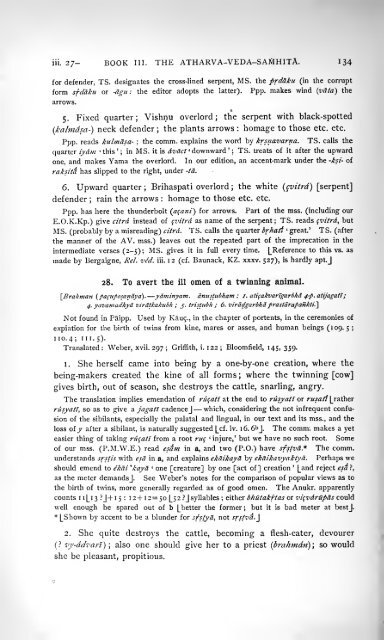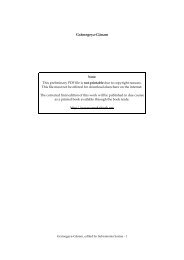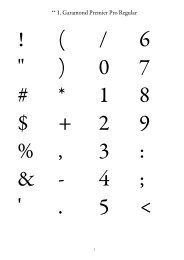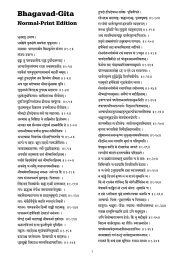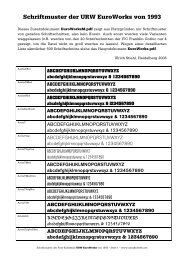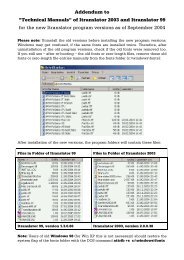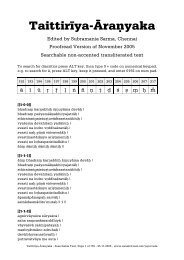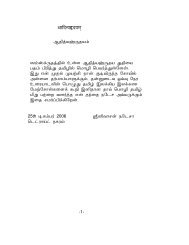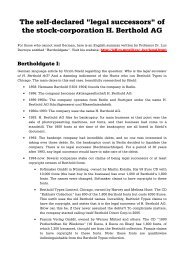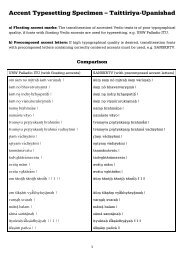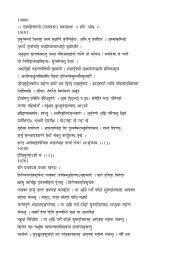- Page 4:
Digitized by the Internet Archive i
- Page 8:
Cambridge, Mass., U.S.A Publication
- Page 11 and 12:
R W. CORgIN ATHARVA-VEDA SAMHITA Wi
- Page 13:
• COLLEGI YALENSIS • QVOS SVA A
- Page 16 and 17:
X Contents of Prefatory and Related
- Page 18 and 19:
: xii Co7ttents of General Introduc
- Page 20 and 21:
xiv Contents of General Introductio
- Page 22 and 23:
31 2 xvi CotUents of Appended Auxil
- Page 24 and 25:
xviii Paragraphs in lieu of a Prefa
- Page 26 and 27:
XX Paragraphs in lieu of a Preface
- Page 29 and 30:
EDITOR'S PREFACE Whitney's labors o
- Page 31 and 32:
; ; ; General Scope of this Work xx
- Page 33 and 34:
Partial Rewrititig and Revision by
- Page 35 and 36:
Parts for which the Author is not r
- Page 37 and 38:
Parts for which the Author is not r
- Page 39 and 40:
Parts for which tJie Author is not
- Page 41 and 42:
Meaning of ^''Revised and brought n
- Page 43 and 44:
General Significance of Whiineys Wo
- Page 45 and 46:
Acknowledgments xxxix instalments t
- Page 47 and 48:
; Hianan Personality and the Progre
- Page 50 and 51:
•^ j\ ILLOAM ©WOSIHIT WIlilDTWEY
- Page 52 and 53:
xliv Brief Sketch of Whitney s Life
- Page 54 and 55:
xlvi Brief Sketch of Whitney s Life
- Page 56 and 57:
xlviii Memorial Address by the Edit
- Page 58 and 59:
1 Memorial Address by the Editor Wa
- Page 60 and 61:
Hi Memorial Address by the Editor t
- Page 62 and 63:
! liv Memorial Address by the Edito
- Page 64 and 65:
SELECT LIST OF WHITNEY'S WRITINGS T
- Page 66 and 67:
+ Iviii Select List of Whitney s Wr
- Page 68 and 69:
J \ Ix Select List of Whitney s Wri
- Page 71 and 72:
GENERAL INTRODUCTION, PART I. BY TH
- Page 73 and 74:
I . Readings of European Mss. of th
- Page 75 and 76:
3- Readings of the India7i Oral Rec
- Page 77 and 78:
\ 5 Readings of tlie Pada-patlia Ix
- Page 79 and 80:
6. Tlie Prati^dkhya and its Comment
- Page 81 and 82:
7- T/ie Anukratnaifis : ''Old" and
- Page 83 and 84:
8. The Kau^ika-Sutra and t!u Vditan
- Page 85 and 86:
8. Tlu Kaufika-Sulra and the Vaitan
- Page 87 and 88:
8. The Kaugika-Sutra and tJie Vaita
- Page 89 and 90:
g. Readings of the Kashmirian or Pa
- Page 91 and 92:
9. Readings of tite Kaskmiriait or
- Page 93 and 94:
9- Readings of the Kashmirian or Pa
- Page 95 and 96:
9- Readings of the Kashmirian or Pa
- Page 97 and 98:
; 9. Readings of the Kashmirian or
- Page 99 and 100:
; lo. Readings of tlie Parallel Tex
- Page 101 and 102:
II. Whitney s Commentary xciii text
- Page 103 and 104:
1 ; 12. Whitney s Translation xcv i
- Page 105 and 106:
! author ; 12. Whitney s Translatio
- Page 107 and 108:
—; of xix. 47 that the idea of 12
- Page 109 and 110:
1 3. Abbreviations and Signs explai
- Page 111 and 112:
13. Abbreviatio7is and Signs explai
- Page 113 and 114:
13. Abbreviations and Signs explain
- Page 115:
L 14- Tabular View of Travislatioti
- Page 118 and 119:
J \ J k ex General Introductio7i, P
- Page 120 and 121:
J cxii General Introduction, Part I
- Page 122 and 123:
; cxiv General Introduction, Part I
- Page 124 and 125:
J J \ cxvi General Introduction, Pa
- Page 126 and 127:
J J J J cxviii General Introduction
- Page 128 and 129:
cxx General Introduction^ Part II.
- Page 130 and 131:
— cxxii General Introduction, Par
- Page 132 and 133:
J J cxxiv General Introduction, Par
- Page 134 and 135:
J J cxxvi General Introduction, Par
- Page 136 and 137:
J ; cxxviii General Introduction, P
- Page 138 and 139:
J J cxxx General Introduction, Part
- Page 140 and 141:
J J cxxxii General Introduction, Pa
- Page 142 and 143:
J cxxxiv General Introduction, Part
- Page 144 and 145:
J cxxxvi General Introduction^ Part
- Page 146 and 147:
J cxxxvlii General Introduction, Pa
- Page 148 and 149:
J J : : cxl Ge7ieral Introduction,
- Page 150 and 151:
J J J J cxlii General Introduction,
- Page 152 and 153:
cxliv General Introductio7i, Part I
- Page 154 and 155:
J cxlvi General Introduction, Part
- Page 156 and 157:
cxlviii General Introduction, Part
- Page 158 and 159:
and, J 5; cl General Introduction,
- Page 160 and 161:
J J J clii General Introduction, Pa
- Page 162 and 163:
J cliv General Introduction, Part I
- Page 164 and 165:
clvi General Introduction, Part II.
- Page 166 and 167:
clviii General Introduction, Part I
- Page 168 and 169:
J J clx General Introduction, Part
- Page 170 and 171:
Cross-references to Explanation of
- Page 172 and 173:
i. I- BOOK I. THE ATHARVA-VEDA-SAMH
- Page 174 and 175:
J i. 3- BOOK I. THE ATHARVA-VEDA-SA
- Page 176 and 177:
i. 5- BOOK I. THE ATHARVA-VEDA-SAMH
- Page 178 and 179:
J —; i. 7- BOOK I. THE ATHARVA-VE
- Page 180 and 181:
i. 9- BOOK I. THE ATHARVA-VEDA-SAMH
- Page 182 and 183:
J i. II- BOOK I. THE ATHARVA-VEDA-S
- Page 184 and 185:
i. 12- BOOK I. THE ATHARVA-VEDA-SAM
- Page 186 and 187:
: i. 14- BOOK I. THE ATHARVA-VEDA-S
- Page 188 and 189:
L l6- BOOK I. THE ATHARVA-VEDA-SAMH
- Page 190 and 191:
: i. 1 8- BOOK I. THE ATHARVA-VEDA-
- Page 192 and 193:
J 1. 21- BOOK I. THE ATHARVA-VEDA-S
- Page 194 and 195:
; i. 23- BOOK I. THE ATHARVA-VEDA-S
- Page 196 and 197:
i. 25- BOOK I. THE ATHARVA-VEDA-SAM
- Page 198 and 199:
dmistubham i i. 27- BOOK I. THE ATH
- Page 200 and 201:
J i. 29- BOOK I. THE ATHARVA-VEDA-S
- Page 202 and 203:
i. 31- BOOK I. THE ATHARVA-VEDA-SAM
- Page 204 and 205:
; i. 33- BOOK I. THE ATHARVA-VEDA-S
- Page 206 and 207:
i. 35 BOOK I. THE ATHARVA-VEDA-SAMH
- Page 208 and 209:
J J ii. I- BOOK II. THE ATHARVA-VED
- Page 210 and 211:
ii. 2- BOOK II. THE ATHARVA-VEDA-SA
- Page 212 and 213:
ii. 4- BOOK II. THE ATHARVA-VEDA-SA
- Page 214 and 215:
:; ii. 5- BOOK II. THE ATHARVA-VEDA
- Page 216 and 217:
J ii. 6- BOOK II. THE ATHARVA-VEDA-
- Page 218 and 219:
J ; ii. 7- BOOK II. THE ATHARVA-VED
- Page 220 and 221:
ii. 9- BOOK II. THE ATHARVA-VEDA-SA
- Page 222 and 223:
ii. 10- BOOK II. THE ATHARVA-VEDA-S
- Page 224 and 225:
; ii. 12- BOOK II. THE ATHARVA-VEDA
- Page 226 and 227:
; ii. 12- BOOK II. THE ATHARVA-VEDA
- Page 228 and 229:
ii. 14- BOOK II. THE ATHARVA-VEDA-S
- Page 230 and 231:
! / ! ! ii. 15- BOOK II. THE ATHARV
- Page 232 and 233:
.. ! ! : 11. I«- BOOK II. THE ATHA
- Page 234 and 235:
J ii. 24- BOOK II. THE ATHARVA-VEDA
- Page 236 and 237:
. J ; ii. 26- BOOK II. THE ATHARVA-
- Page 238 and 239:
J ii. 27- BOOK II. THE ATHARVA-VEDA
- Page 240 and 241:
ii. 29- BOOK II. THE ATHARVA-VEDA-S
- Page 242 and 243:
. : ii. 30- BOOK II. THE ATHARVA-VE
- Page 244 and 245:
ii. 31- BOOK II. THE ATHARVA-VEDA-S
- Page 246 and 247:
ii. 33- BOOK II. THE ATHARVA-VEDA-S
- Page 248 and 249:
ii. 34- BOOK II. THE ATHARVA-VEDA-S
- Page 250 and 251:
; ii. 35- BOOK II. THE ATHARVA-VEDA
- Page 252 and 253:
J ; ii. 36- BOOK II. THE ATHARVA-VE
- Page 254 and 255: ; Book III. LThe third book is made
- Page 256 and 257: iii. 2- BOOK III. THE ATHARVA-VEDA-
- Page 258 and 259: iii. 3- BOOK III. THE ATHARVA-VEDA-
- Page 260 and 261: ; iii. 4- BOOK III. THE ATHARVA-VED
- Page 262 and 263: J iii. 5- BOOK III. THE ATHARVA-VED
- Page 264 and 265: J" ; iii. 6- BOOK III. THE ATHARVA-
- Page 266 and 267: iii. 8- BOOK III. THE ATHARVA-VEDA-
- Page 268 and 269: . ; : iii. 8- BOOK III. THE ATHARVA
- Page 270 and 271: \ ; lii. lO- BOOK III. THE ATHARVA-
- Page 272 and 273: . iii. lO- BOOK III. THE ATHARVA-VE
- Page 274 and 275: ; iii. II- BOOK III. THE ATHARVA-VE
- Page 276 and 277: J iii. 12- BOOK III. THE ATHARVA-VE
- Page 278 and 279: : iii. 13- BOOK III. THE ATHARVA-VE
- Page 280 and 281: iii. 14- BOOK III. THE ATHARVA-VEDA
- Page 282 and 283: : iii. IS- BOOK III. THE ATHARVA-VE
- Page 284 and 285: J \ ; iii. 16- BOOK III. THE ATHARV
- Page 286 and 287: ; iii. 17- BOOK III. THE ATHARVA-VE
- Page 288 and 289: iil l8- BOOK III. THE ATHARVA-VEDA-
- Page 290 and 291: . sharp iii. 19- BOOK III. THE ATHA
- Page 292 and 293: iii. 20- BOOK III. THE ATHARVA-VEDA
- Page 294 and 295: J iii. 21- BOOK III. THE ATHARVA-VE
- Page 296 and 297: iii. 21- BOOK III. THE ATHARVA-VEDA
- Page 298 and 299: ; iii. 23- BOOK III. THE ATHARVA-VE
- Page 300 and 301: iii. 24- BOOK III. THE ATHARVA-VEDA
- Page 302 and 303: ! J iii. 26- BOOK III. THE ATHARVA-
- Page 306 and 307: . iii. 29- BOOK III. THE ATHARVA-VE
- Page 308 and 309: ; iii. 30- BOOK III. THE ATHARVA-VE
- Page 310 and 311: ; iii. 31- BOOK III. THE ATHARVA-VE
- Page 312 and 313: ; Book IV. LThe fourth book is made
- Page 314 and 315: iv, I- BOOK IV. THE ATHARVA-VEDA-SA
- Page 316 and 317: : iv. 2- BOOK IV. THE ATHARVA-VEDA-
- Page 318 and 319: i iv. 2- BOOK IV. THE ATHARVA-VEDA-
- Page 320 and 321: ! ; iv. 4- BOOK IV. THE ATHARVA-VED
- Page 322 and 323: iv. 5- BOOK IV. THE ATHARVA-VEDA-SA
- Page 324 and 325: IV, 6- BOOK IV. THE ATHARVA-VEDA-SA
- Page 326 and 327: " iv. 7- BOOK IV. THE ATHARVA-VEDA-
- Page 328 and 329: ; iv. 8- BOOK IV. THE ATHARVA-VEDA-
- Page 330 and 331: iv. 9- BOOK IV. THE ATHARVA-VEDA-SA
- Page 332 and 333: ! ; iv. lO- BOOK IV. THE ATHARVA-VE
- Page 334 and 335: iv. II- BOOK IV. THE ATHARVA-VEDA-S
- Page 336 and 337: ; iv. II- BOOK IV. THE ATHARVA-VEDA
- Page 338 and 339: iv. 12- BOOK IV. THE ATHARVA-VEDA-S
- Page 340 and 341: iv. 14- BOOK IV. THE ATHARVA-VEDA-S
- Page 342 and 343: ; ; ; iv. 14- BOOK IV. THE ATHARVA-
- Page 344 and 345: ; iv. 15- BOOK IV. THE ATHARVA-VEDA
- Page 346 and 347: " iv. 15- BOOK IV. THE ATHARVA-VEDA
- Page 348 and 349: J iv. l6- BOOK IV. THE ATHARVA-VEDA
- Page 350 and 351: iv. 17- BOOK IV. THE ATHARVA-VEDA-S
- Page 352 and 353: J iv. l8- BOOK IV. THE ATHARVA-VEDA
- Page 354 and 355:
; iv. 19- BOOK IV. THE ATHARVA-VEDA
- Page 356 and 357:
J iv. 20- BOOK IV. THE ATHARVA-VEDA
- Page 358 and 359:
iv. 21- BOOK IV. THE ATHARVA-VEDA-S
- Page 360 and 361:
J : J: iv. 23- BOOK IV. THE ATHARVA
- Page 362 and 363:
; iv. 24- BOOK IV. THE ATHAKVA-VEDA
- Page 364 and 365:
iv. 25- BOOK IV. THE ATHARVA-VEDA-S
- Page 366 and 367:
iv. 27- BOOK IV. THE ATHARVA-VEDA-S
- Page 368 and 369:
\ J iv. 28- BOOK IV. -THE ATHARVA-V
- Page 370 and 371:
; iv. 30- BOOK IV. THE ATHARVA-VEDA
- Page 372 and 373:
iv. 31- BOOK IV. THE ATHARVA-VEDA-S
- Page 374 and 375:
iv. 32- BOOK IV. THE ATHARVA-VEDA-S
- Page 376 and 377:
\ iv. 34- BOOK IV. THE ATHARVA-VEDA
- Page 378 and 379:
; Iv. 34- BOOK IV. THE ATHARVA-VEDA
- Page 380 and 381:
; iv. 36- BOOK IV. THE ATHARVA-VEDA
- Page 382 and 383:
J : iv. 37- BOOK IV. THE ATHARVA-VE
- Page 384 and 385:
; iv. 38- BOOK IV. THE ATHARVA-VEDA
- Page 386 and 387:
! iv. 38- BOOK IV. THE ATHARVA-VEDA
- Page 388 and 389:
. J iv. 40- BOOK IV. THE ATHARVA-VE
- Page 390 and 391:
Book V. LThe fifth book is made up
- Page 392 and 393:
V. 1- BOOK V. THE ATHARVA-VEDA-SAMH
- Page 394 and 395:
; V. 2- BOOK V. THE ATHARVA-VEDA-SA
- Page 396 and 397:
V. 3- BOOK V. THE ATHARVA-VEDA-SAWH
- Page 398 and 399:
; V. 4- BOOK V. THE ATHARVA-VEDA-SA
- Page 400 and 401:
V. 5- BOOK V. THE ATHARVA-VEDA-SAMH
- Page 402 and 403:
J ; V. 6- BOOK V. THE ATHARVA-VEDA-
- Page 404 and 405:
V. 8- BOOK V. THE ATHARVA-VEDA-SAWH
- Page 406 and 407:
V. lO- BOOK V. THE ATHARVA-VEDA-SAW
- Page 408 and 409:
i V. II- BOOK V. THE ATHARVA-VEDA-S
- Page 410 and 411:
V. 12- BOOK V. THE ATHARVA-VEDA-SAS
- Page 412 and 413:
V. 13- BOOK V. THE ATHARVA-VEDA-SAl
- Page 414 and 415:
. J most sapless. begins with kanvd
- Page 416 and 417:
V. 14- BOOK V. THE ATHARVA-VEDA-SAM
- Page 418 and 419:
: V. 17- BOOK V. THE ATHARVA-VEDA-S
- Page 420 and 421:
J V. 17- BOOK V. THE ATHARVA-VEDA-S
- Page 422 and 423:
; ; V. 1 8- BOOK V. THE ATHARVA-VED
- Page 424 and 425:
V. 19- BOOK V. THE ATHARVA-VEDA-SAK
- Page 426 and 427:
J V. 20- BOOK V. THE ATHARVA-VEDA-S
- Page 428 and 429:
! — V. 21- BOOK V. THE ATHARVA-VE
- Page 430 and 431:
V. 22- BOOK V. THE ATHARVA-VEDA-SAM
- Page 432 and 433:
; V. 23- BOOK V. THE ATHARVA-VEDA-S
- Page 434 and 435:
! V. 24- BOOK V. THE ATHARVA-VEDA-S
- Page 436 and 437:
J; V. 25- BOOK V. THE ATHARVA-VEDA-
- Page 438 and 439:
! ! ! ! ! ! V. 26- BOOK V. THE ATHA
- Page 440 and 441:
— . V. 27- BOOK V. THE ATHARVA-VE
- Page 442 and 443:
V. 28- BOOK V. THE ATHARVA-VEDA-SAK
- Page 444 and 445:
V. 28- BOOK V. THE ATHARVA-VEDA-SAK
- Page 446 and 447:
; V. 29- BOOK V. THE ATHARVA-VEDA-S
- Page 448 and 449:
V. 30- BOOK V. THE ATHARVA-VEDA-SAJ
- Page 450 and 451:
. J : V. 31 BOOK V. THE ATHARVA-VED
- Page 452 and 453:
J vi. I- BOOK VI. THE ATHARVA-VEDA-
- Page 454 and 455:
; vi. 3- BOOK VI. ATHARVA-VEDA-SAMH
- Page 456 and 457:
vi. 6- BOOK VI. THE ATHARVA-VEDA-SA
- Page 458 and 459:
! ; vi. 9- BOOK VI. THE ATHARVA-VED
- Page 460 and 461:
vi. 12- BOOK VI. THE ATHARVA-VEDA-S
- Page 462 and 463:
. \ : vi. l6- BOOK VI. THE ATHARVA-
- Page 464 and 465:
; vi. 1 8- BOOK VI. THE ATHARVA-VED
- Page 466 and 467:
vi. 21- BOOK VI. THE ATHARVA-VEDA-S
- Page 468 and 469:
vi. 23- BOOK VI. THE ATHARVA-VEDA-S
- Page 470 and 471:
J vi. 27- BOOK VI. THE ATHARVA-VEDA
- Page 472 and 473:
i vi. 30- BOOK VI. THE ATHARVA-VEDA
- Page 474 and 475:
J ; vi. 31- BOOK VI. THE ATHARVA-VE
- Page 476 and 477:
vi. 34- BOOK VI. THE ATHARVA-VEDA-S
- Page 478 and 479:
vi. 36- BOOK VI. THE ATHARVA-VEDA-S
- Page 480 and 481:
i vi. 39- BOOK VI. THE ATHARVA-VEDA
- Page 482 and 483:
— . J vi. 42- BOOK VI. THE ATHARV
- Page 484 and 485:
J Vi. 45- BOOK VI. THE ATHARVA-VEDA
- Page 486 and 487:
! ;. vi. 48- BOOK VI. THE ATHARVA-V
- Page 488 and 489:
vi. so- BOOK VI. THE ATHARVA-VEDA-S
- Page 490 and 491:
vi. 52- BOOK VI. THE ATHARVA-VEDA-S
- Page 492 and 493:
vi. 54- BOOK VI. THE ATHARVA-VEDA-S
- Page 494 and 495:
J J; vi. 57- BOOK VI. THE ATHARVA-V
- Page 496 and 497:
; vi. 60- BOOK VI. THE ATHARVA-VEDA
- Page 498 and 499:
I has vi 62- BOOK VI. THE ATHARVA-V
- Page 500 and 501:
J vi. 64- BOOK VI. THE ATHARVA-VEDA
- Page 502 and 503:
J vi. 68- BOOK VI. THE ATHARVA-VEDA
- Page 504 and 505:
—' vi. 70- BOOK VI. THE ATHARVA-V
- Page 506 and 507:
vi. 73- BOOK VI. THE ATHARVA-VEDA-S
- Page 508 and 509:
vi. 75- BOOK VI. THE ATHARVA-VEDA-S
- Page 510 and 511:
vi. 78- BOOK VI. THE ATHARVA-VEDA-S
- Page 512 and 513:
. J ; vi. 8l- BOOK VI. THE ATHARVA-
- Page 514 and 515:
! vi. 84- BOOK VI. THE ATHARVA-VEDA
- Page 516 and 517:
vi. 87- BOOK VI. THE ATHARVA-VEDA-S
- Page 518 and 519:
vi. 91- BOOK VI. THE ATHARVA-VEDA-S
- Page 520 and 521:
. J ; vi. 94- BOOK VI. THE ATHARVA-
- Page 522 and 523:
. ; vi. 97- BOOK VI. THE ATHARVA-VE
- Page 524 and 525:
. \ vi. lOO- BOOK VI. THE ATHARVA-V
- Page 526 and 527:
vi. 103- BOOK VI. THE ATHARVA-VEDA-
- Page 528 and 529:
vi. I06- BOOK VI. THE ATHARVA-VEDA-
- Page 530 and 531:
J \ —; vi. 109- BOOK VI. THE ATHA
- Page 532 and 533:
vi. 112- BOOK VI. THE ATHARVA-VEDA-
- Page 534 and 535:
J vi. 114- BOOK VI. THE ATHARVA-VED
- Page 536 and 537:
: vl. Il6- BOOK VI. THE ATHARVA-VED
- Page 538 and 539:
\ :; vi. Il8- BOOK VI. THE ATHARVA-
- Page 540 and 541:
J ; vi. 1 20- BOOK VI. THE ATHARVA-
- Page 542 and 543:
vi. 122- BOOK VI. THE ATHARVA-VEDA-
- Page 544 and 545:
; vi. 124- BOOK VI. THE ATHARVA-VED
- Page 546 and 547:
; vi. 126- BOOK VI. THE ATHARVA-VED
- Page 548 and 549:
vi. 128- BOOK VI. THE ATHARVA-VEDA-
- Page 550 and 551:
; vi. 131- BOOK VI. THE ATHARVA-VED
- Page 552 and 553:
vi. 134- BOOK VI. THE ATHARVA-VEDA-
- Page 554 and 555:
; vi. 138- BOOK VI. THE ATHARVA-VED
- Page 556 and 557:
vi. 140- BOOK VI. THE ATHARVA-VEDA-
- Page 558 and 559:
: : : : Book VII. [The seventh book
- Page 560 and 561:
vii. I- BOOK VII. THE ATHARVA-VEDA-
- Page 562 and 563:
; vii. 5- BOOK VII. THE ATHARVA-VED
- Page 564 and 565:
— vii. 6- BOOK VII. THE ATHARVA-V
- Page 566 and 567:
vii. lO- BOOK VII. THE ATHARVA-VEDA
- Page 568 and 569:
J vii. 14- BOOK VII. THE ATHARVA-VE
- Page 570 and 571:
J J :; vii. 17- BOOK VII. THE ATHAR
- Page 572 and 573:
; vii. 20- BOOK VII. THE ATHARVA-VE
- Page 574 and 575:
J vii. 22- BOOK VII. THE ATHARVA-VE
- Page 576 and 577:
J ; vii. 26- BOOK VII. THE ATHARVA-
- Page 578 and 579:
; vii. 28- BOOK VII. THE ATHARVA-VE
- Page 580 and 581:
J ; vii. 32- BOOK VII. THE ATHARVA-
- Page 582 and 583:
vii. 36- BOOK VII. THE ATHARVA-VEDA
- Page 584 and 585:
: vil 39- BOOK VII. THE ATHARVA-VED
- Page 586 and 587:
' vii. 43- BOOK VII. THE ATHARVA-VE
- Page 588 and 589:
; Vii. 46- BOOK VII. THE ATHARVA-VE
- Page 590 and 591:
vii. 50- BOOK VII. THE ATHARVA-VEDA
- Page 592 and 593:
vii. SI- BOOK VII. THE ATHARVA-VEDA
- Page 594 and 595:
J vii. 53- BOOK VII. THE ATHARVA-VE
- Page 596 and 597:
; vii. 56- BOOK VII. THE ATHARVA-VE
- Page 598 and 599:
vii. 58- BOOK VII. THE ATHARVA-VEDA
- Page 600 and 601:
J . vii. 60- BOOK VII. THE ATHARVA-
- Page 602 and 603:
I The vii. 64- BOOK VII. THE ATHARV
- Page 604 and 605:
vii. 68- BOOK VII. THE ATHARVA-VEDA
- Page 606 and 607:
J \ J vii. 71- BOOK VII. THE ATHARV
- Page 608 and 609:
\ vii. Tl- BOOK VII. THE ATHARVA-VE
- Page 610 and 611:
J vii. 74- BOOK VII. THE ATHARVA-VE
- Page 612 and 613:
:. vii. 76- BOOK VII. THE ATHARVA-V
- Page 614 and 615:
vii. 78- BOOK VII. THE ATHARVA-VEDA
- Page 616 and 617:
vii. 80- BOOK VII. THE ATHARVA-VEDA
- Page 618 and 619:
; vii. 8l- BOOK VII. THE ATHARVA-VE
- Page 620 and 621:
vii. 83- BOOK VII. THE ATHARVA-VEDA
- Page 622 and 623:
vii. 8s- BOOK VII. THE ATHARVA-VEDA
- Page 624 and 625:
; vii. 89- BOOK VII. THE ATHARVA-VE
- Page 626 and 627:
J vii. 92- BOOK VII. THE ATHARVA-VE
- Page 628 and 629:
vii. 96- BOOK VII. THE ATHARVA-VEDA
- Page 630 and 631:
! vii. 97- BOOK VII. THE ATHARVA-VE
- Page 632 and 633:
vii. I02- BOOK VII. THE ATHARVA-VED
- Page 634 and 635:
J vii. Io8- BOOK VII. THE ATHARVA-V
- Page 636 and 637:
vii. I 10- BOOK VII. THE ATHARVA-VE
- Page 638 and 639:
; vii. 113- BOOK VII. THE ATHARVA-V
- Page 640:
; vii. Il6 BOOK VII. THE ATHARVA-VE


